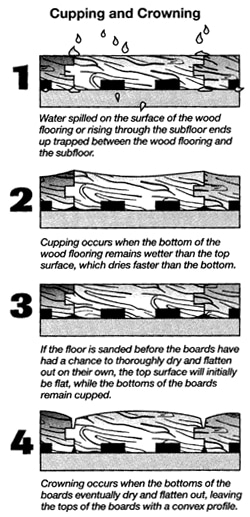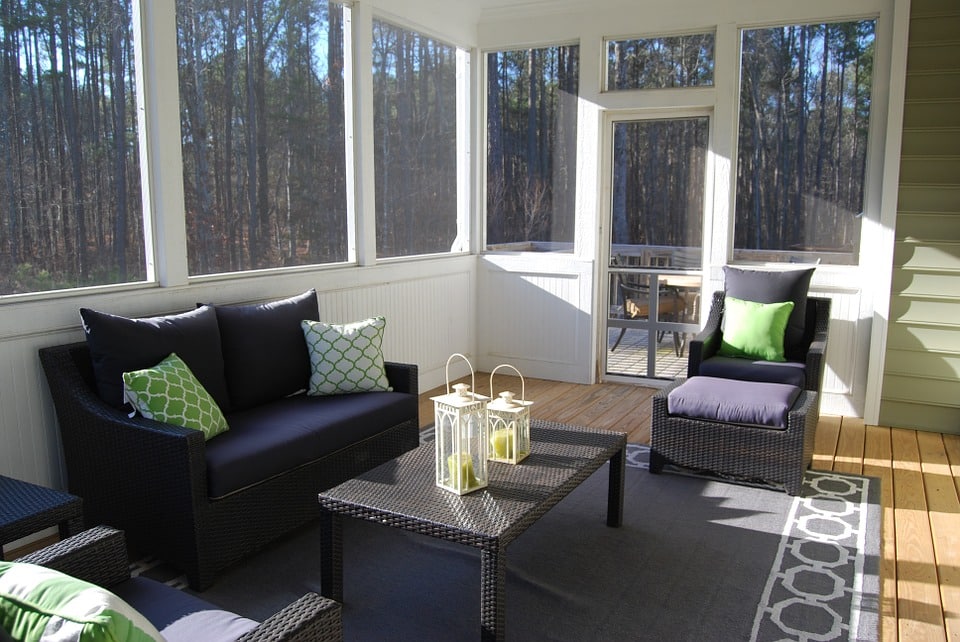What You Need To Know About Your Wood Flooring
Though it seemed we would never get out of Chicago’s eternal winter, summer is finally here! With summer comes some new nuisances: longer lines at brunch, noise pollution from Chicago’s Air and Water show, and worst of all, humidity. Humidity can exacerbate allergies and make your hair frizz, but it also causes long-term damage to your hardwood and laminate flooring.
Wood is a hygroscopic material, meaning it absorbs moisture from the air in order to maintain equilibrium with its surrounding. Studies have found when the humidity level is over 55%, your hardwood and laminates floors are at risk for permanent damage if not cared for properly. Absorbing too much moisture in the air will cause your flooring to swell, creating pressure between the boards and triggering permanent warping. Three types of issues can arise from dangerously high humidity levels: cupping, crowning, and buckling.
Cupping
 Cupping occurs when high levels of humidity cause the edges of the floorboards to curve up higher than the center of the board, creating a concave shape. Humidity isn’t the only enemy of wood floors, as cupping can also be caused by water spills on wood. Severe cupping should be addressed by a professional so that the edges can get sanded down, but often minor cupping will resolve itself as moisture in the air dissipates.
Cupping occurs when high levels of humidity cause the edges of the floorboards to curve up higher than the center of the board, creating a concave shape. Humidity isn’t the only enemy of wood floors, as cupping can also be caused by water spills on wood. Severe cupping should be addressed by a professional so that the edges can get sanded down, but often minor cupping will resolve itself as moisture in the air dissipates.
Crowning
This is the opposite of cupping, where the center of the board rises, creating an inverted U shape. Often this occurs as a result of trying to fix cupped floors before they have time to return to equilibrium. If the edges of a piece of wood are sanded down before the wood has a chance to return to its natural state, the center of the board rises above the edges.
Buckling
Buckling is the worst reaction that your floors can have to moisture. The wood has such an extreme reaction to moisture that it separates from the subfloor and can rise several inches in multiple places. The likelihood of this happening due to moisture from humidity is slim, but can be a result of flooding.
Wood floors are an investment and, if done properly, can outlast you and stay in good condition for a very long time. Ideally, your home humidity level should be between 30-40 percent, otherwise you could run into issues.
Four Steps to Protect Your Wood Floors Against Crippling Summer Humidity.
1) Check the Humidity Levels in Your House
The first step to maintaining your wood floors is to know what the humidity level in your house is like. Basements, bathrooms, and rooms with fish tanks are all naturally at high risk for overexposure to humidity year round, which can be made worse as humidity rises during the summer. Keep a humidistat or hydrometer in your home and check it daily to make sure that it stays around 30-40 percent. These can be found at your local home improvement or hardware store. By maintaining the humidity in the room, your wood floors will maintain equilibrium and minimize and shifting that could occur as a result of humidity damage.
2) Use a Dehumidifier
The best option for maintaining the relative humidity in your house is to use a dehumidifier during the summer. A good dehumidifier will be able to detect the humidity level in your house and automatically shut off to your specifications. When shopping for a dehumidifier, make sure that the unit has an adjustable humidistat, meaning that you can set your desired relative humidity level.
A general rule of thumb for choosing a dehumidifier best suited for your space:
- 400 square feet or under: 25 or 30 pint dehumidifier
- 800 square feet or under: 40 pint dehumidifier
- 100 square feet or under: 50 pint dehumidifier
- 1300 square feet or under: 65 pint dehumidifier
3) Ventilate and Use Fans
Make sure that your house is properly ventilated. Ventilation increases airflow and will help reduce humidity. During the summer, consider running your fan even when the AC isn’t on to keep the air in the room circulating. Speaking of fans, make sure you run the fan in your bathroom when taking a warm shower and utilize the exhaust fan on stoves and microwaves when cooking.
4) Check for Early Signs of Humidity Damage
If all else fails, early diagnosis is the key to fixing moisture damage before it becomes permanent damage. Keep an eye on your wood floors for any signs of cracks between boards, cupping, crowning, or buckling. If you begin to see any of these signs, consider calling your local flooring expert to resolve the problem.
Too often we see beautiful hardwood flooring in Chicago homes showing early signs of humidity damage. The manufacturers we use offer pre-finished hardwood floors that are more durable and easier to maintain than ever before. With our professional hardwood flooring services and this guide, we hope to make your home as beautiful as possible and help it remain that way for a long time.

